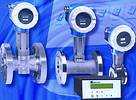
Nearly 20 years ago, measurement experts agreed that vortex meters would make orifice plates obsolete. Even then, the value proposition was clear. With vortex meters, installation is easier, life cycle costs are much lower, and the same meter can be used for steam, gas or liquid applications. Yet, the vortex meter has struggled to gain superiority in the market due to a number of key factors.
To begin with, first generation vortex meter designs proved very sensitive to vibration, fluid pulsation and hydraulic noise, causing the meter to indicate a flow where none was present. The next advance was the incorporation of piezoelectric crystal sensor technology into vortex designs. However, piezoelectric crystals are sensitive to large temperature gradients and easily damaged in cryogenic applications and service where pipe blow-downs routinely occur.

Most modern vortex meters use piezoelectric crystals as sensors, yet they react to pulsations and hydraulic noise by emitting a momentary output in the form of a voltage spike. As long as the amplitude of the spike is below the trigger level (the minimum sensitivity of the electronics), the activity is inconsequential. However, if the spike from the vortex sensor is of sufficient amplitude, the vortex meter's electronics produce an output.
Unfortunately, the piezoelectric crystal cannot distinguish between spikes created by the vortex shedding process and spikes generated by vibration - installations where the frequency of the vibration is high have yielded outputs as high as 80.
Raising the trigger level can solve this issue in some instances. Yet, when the trigger level is raised, so too is the flow signal amplitude required for a legitimate flow output signal. This means that when the meter was originally able to meter down to 5% of the meter's span, it may now only be capable of metering down to 8% of the span. In many instances the reduced flow range capability is unacceptable.
Another approach to deal with the noise issue involves installing a proximity switch on the control valve, hence when the valve is shut the power to the vortex meter is interrupted. While this solves the problem, it also results in an output of 0 mA instead of the normal 4 mA at zero flow. Systems that are programmed to expect a signal between 4 and 20 mA, could respond by triggering an alarm signal.
Redesigning the meter and sensor bodies to allow the shedder bar to flex, thus alleviating the stress in the crystals, improved operation. However, consistent manufacturing standards were difficult to achieve.
Positioning of the meter in the correct orientation relative to vibration can also be effective. Vibrations may be broken down into three components or planes of vibration: up and down (Z-axis), forward and backwards (X-axis), and side to side (Y-axis). Movement on the X and Z-axes does not occur on the same plane as the vortex shedding stress and are, thus, less likely to produce vibration. The Y-axis plan of vibration is the most challenging as this movement stresses the sensor, allowing it to mistake the vibration for a true flow signal. By rotating the meter 90° in the pipeline and moving the meter out of the plane of the vibration, improved performance can be achieved.
All of the above offer levels of success regarding the vibration problem, but a more effective meter solution involved elimination of the piezoelectric crystal and replacing it with the capacitance (DSC) sensor design. The DSC sensor is located just behind the shedder bar. The sensor consists of an upper portion isolated by the flexure and a lower portion that is in the flow stream. Both are equally balanced and, when a vibration occurs, are equally affected. As a result, the capacitor plates do not come any closer together or further apart and no output spike is generated.
Tests conducted by Endress+Hauser show that the DSC sensor withstands vibration exceeding 1 g at 20-500 Hz in any plane, without causing an output. When the plane of vibration is in the Z-axis, parallel to the shedder bar, the vibration immunity improves to 3 g without causing a meter output. Other benefits that a DSC sensor provides over the piezoelectric sensor are a cleaner signal with less noise, resistance to thermal shock and water hammer, one sensor for all meter diameters and insensitivity to dirty flows.
These improvements have spurred progress in many application areas, specifically steam, gas and liquid service, and enable future instrument users to achieve the value proposition from the beginning. For the first time the vortex meter provides exceptional immunity to vibration and has evolved to become a versatile tool for many years to come.
For more information contact, Grant Joyce, Endress+Hauser, 011 262 8000, www.za.endress.com
| Tel: | +27 11 262 8000 |
| Email: | [email protected] |
| www: | www.endress.com |
| Articles: | More information and articles about Endress+Hauser South Africa |

© Technews Publishing (Pty) Ltd | All Rights Reserved